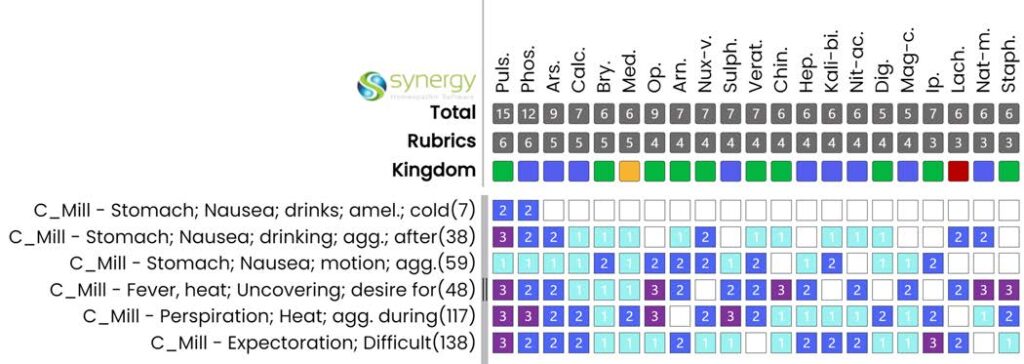
A COVID-19 Patient Treated with Phosphorus
Alex Bekker, MD, ABIHM
Abstract: An RT-PCR Covid-positive patient with previous radiation therapy for melanoma was treated with homeopathy and recovered without any complications. Patient had been previously treated successfully for malaise with Sepia.
Keywords: COVID-19, RT-PCR Covid test, homeopathy, Phosphorus, complementary remedy relationships
History of Present Complaint
This 69-year-old lady, well known to the clinic, tested positive for RT-PCR Covid presented on Monday, October 30th, 2023, with illness starting on Friday October 27th. Patient was seen by a telemedicine consultation.
Illness started with a scratchy throat, cough, achy legs, low appetite, lethargy, and heavy limbs. She developed shortness of breath on exertion by Monday, but her home pulse oximetry was 98% on room air per patient. Her voice became hoarse, and she described this as “laryngitis.”
Characteristic symptoms: Nausea worse eating and drinking, especially drinking water; but cold drinks ameliorated.
Nausea worse motion.
Lethargy with a severe heavy feeling all over the body, especially the limbs.
At night she felt either too hot, necessitating uncovering, or too cold, especially after uncovering.
Sweating was on the torso exclusively at night.
Expectoration—clear, thick and difficult to expel—ameliorated when accomplished.1
Case Analysis
The eliminating rubrics that were used were: nausea, ameliorated by cold drinks, while drinking in general aggravated. Both Pulsatilla and Phosphorus showed up strongly in the repertorization. It was hard to differentiate between these two from the presenting symptoms of the case alone. However, the final choice was made based on the patient’s previous affinity for Sepia, which had helped her overall health in the past and is reciprocally complementary to Phosphorus.
Prescription: Phosphorus 200C, dry dose, size 10 pellets; then one dry dose three times a day for three days.
Result: Patient’s nausea was 75% improved after the first day of treatment. Fever also improved to about the same degree that day. On the second and third day, her shortness of breath, lethargy and heaviness lifted, and the patient made an uneventful recovery.

Browser Edition: HEAVINESS: BRY, Calc, carb-v, chin, con,
GELS, nat-m, NUX-V, ph-ac, PHOS, pic-ac, PULS, RHUS-T, SEP, SULPH]
Discussion
The use of Boger’s General Analysis underlies the need for a
clinical repertory when the strong symptoms are present in a general rubric which includes many remedies. C.M. Boger spent much of his time during the meetings of the International Hahnemannian Association (for which he served as President in 1904) carefully writing down clinical observations and confirmations both from his own presentations and from the cases of reliable authors. When we realize that some of the world’s most eminent homeopathic physicians were presenting during the last part of the 19th and first part of the 20th century, we can learn to value this little clinical work in our practice.
We know that sometimes a remedy that a patient needs to treat a chronic condition may also be needed for an acute condition. However, how often do we see a remedy that is used for an acute condition be complementary to the chronic condition remedy? That is a good question for us to look into more carefully.1 Cowperthwaite, AC. A Text-Book of Materia Medica and Therapeutics. Characteristic, Analytical, and Comparative. Tenth Edition. Philadelphia. Boericke & Tafel. 1909. p. 605 – 608. “Weakness in all the limbs, as if paralyzed … Extremities, especially hands and feet, heavy as lead… Heat at night. Profuse perspiration; at night … The vomiting of Phos. is temporarily relieved by a cold drink … is an exceedingly valuable remedy in respiratory diseases, in which it is more often prescribed than in any other form of disease. Laryngitis, with hoarseness and aphonia …”

About the author: Alex Bekker, MD, ABIHM, was introduced to homeopathy by Alain Naudé over thirty-five years ago and has been a student ever since. He has a private General Practice specializing in homeopathy and is an Adjunct Professor at UNTHSC Fort Worth, Texas. He is the current Editor-in-Chief of the American Journal of Homeopathic Medicine.
About the AJHM
The American Journal of Homeopathic Medicine (AJHM) is a peer-reviewed scientific journal, specifically intended to meet the needs of physicians involved in the specialty of homeopathy. The editor invites original manuscripts, feature articles, research reports, 'Homeopathic Grand Rounds' cases studies, abbreviated case reports for 'Clinical Snapshots,' seminar reports, and position papers that focus on homeopathy, as well as book reviews and letters to the editor. Click below to subscribe to the Journal.
Latest Issue of the AJHM

AJHM – Spring 2025
Volume 118 Number 1
Table of Contents
- Editorial: In this issue
- President’s Message: Our Guiding Precepts
- Homeopathic PuZZle?
- Alchemy, Spagyrics, and Homeopathy: Tracing the Threads of Energetic Medicine
- The Genius of Fluoricum acidum: Part One
- An Interesting Case of Kola
- Book Review: ‘Lessons in Pure Homeopathy, From the Writings of Hahnemann’s Best Student and Medicine’s Most Successful Practitioner, Adolph Lippe, MD’ – Edited & Annotated by A. Saine, ND
- Book Review: ‘Folkways and Homoeopathy: Our Ancestral Secret of Healing’ by Shailendra Ramchandra Vaishampayan


